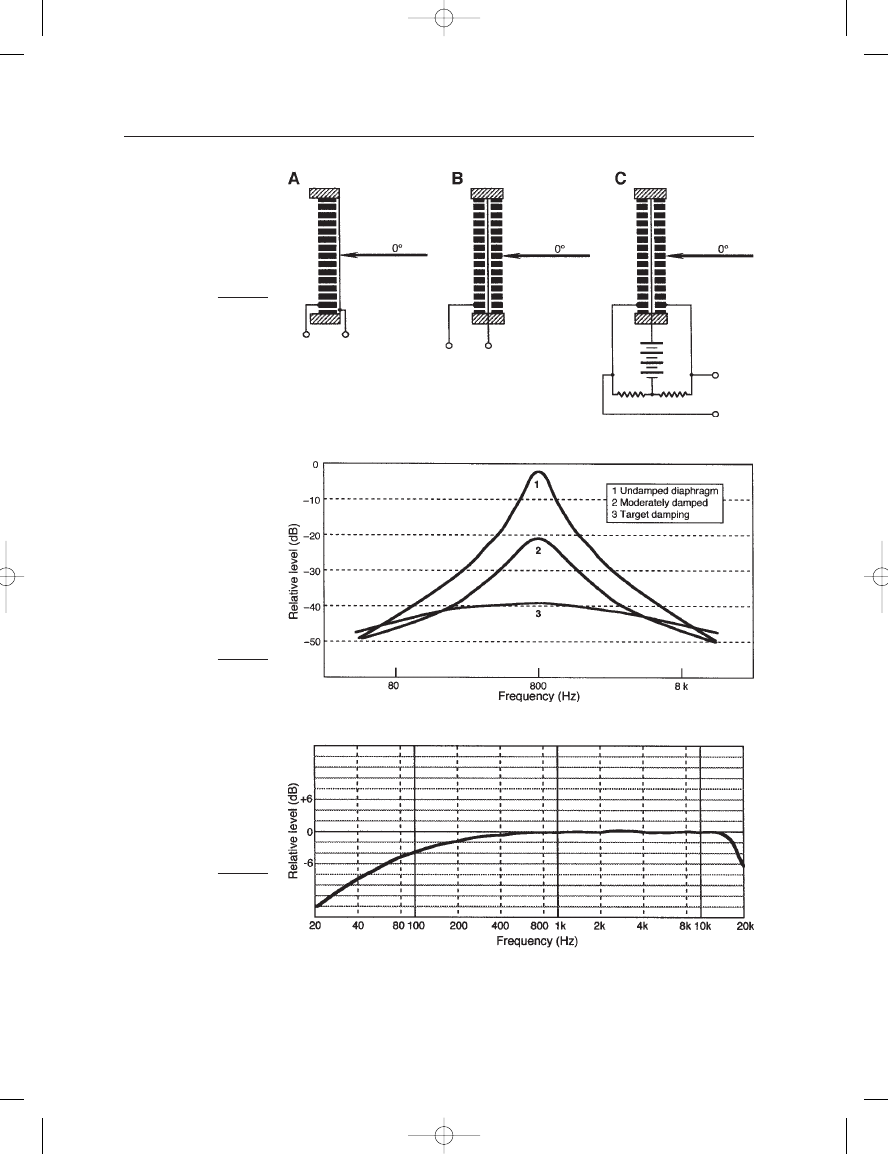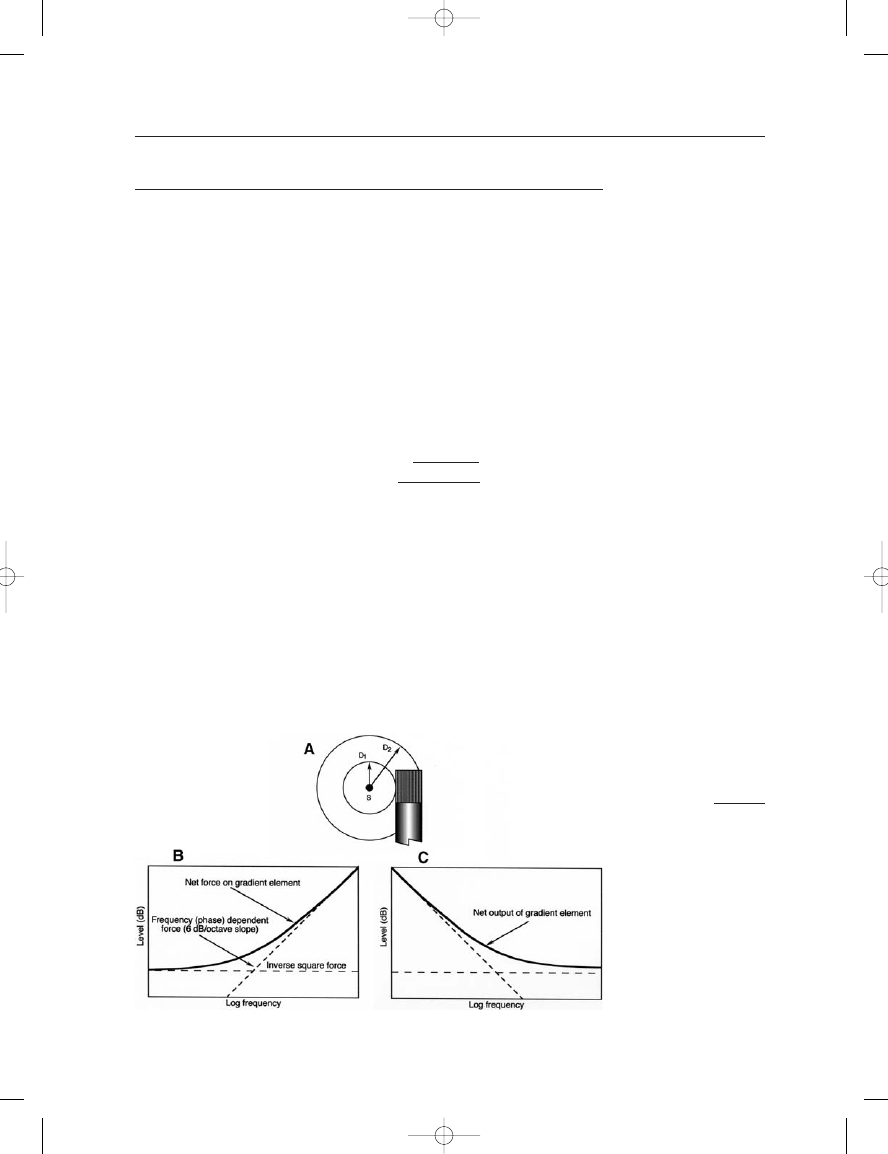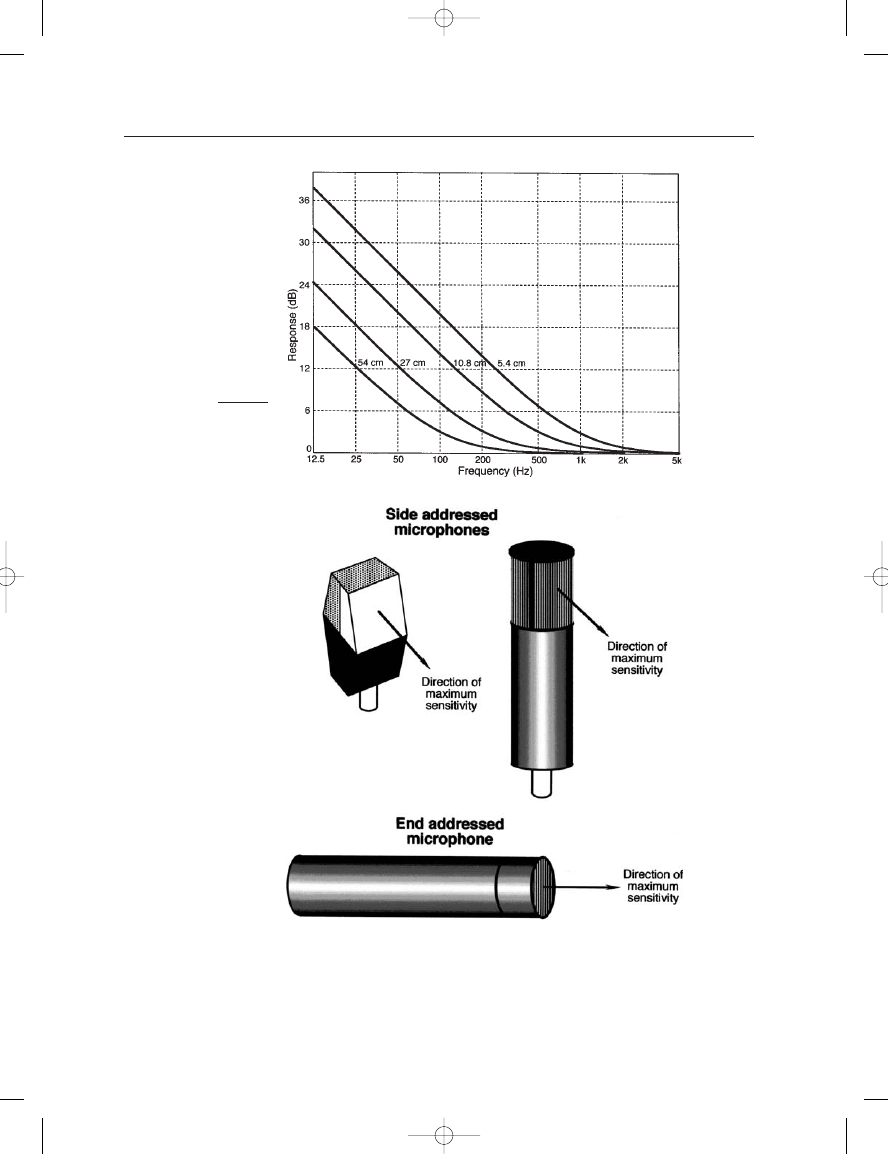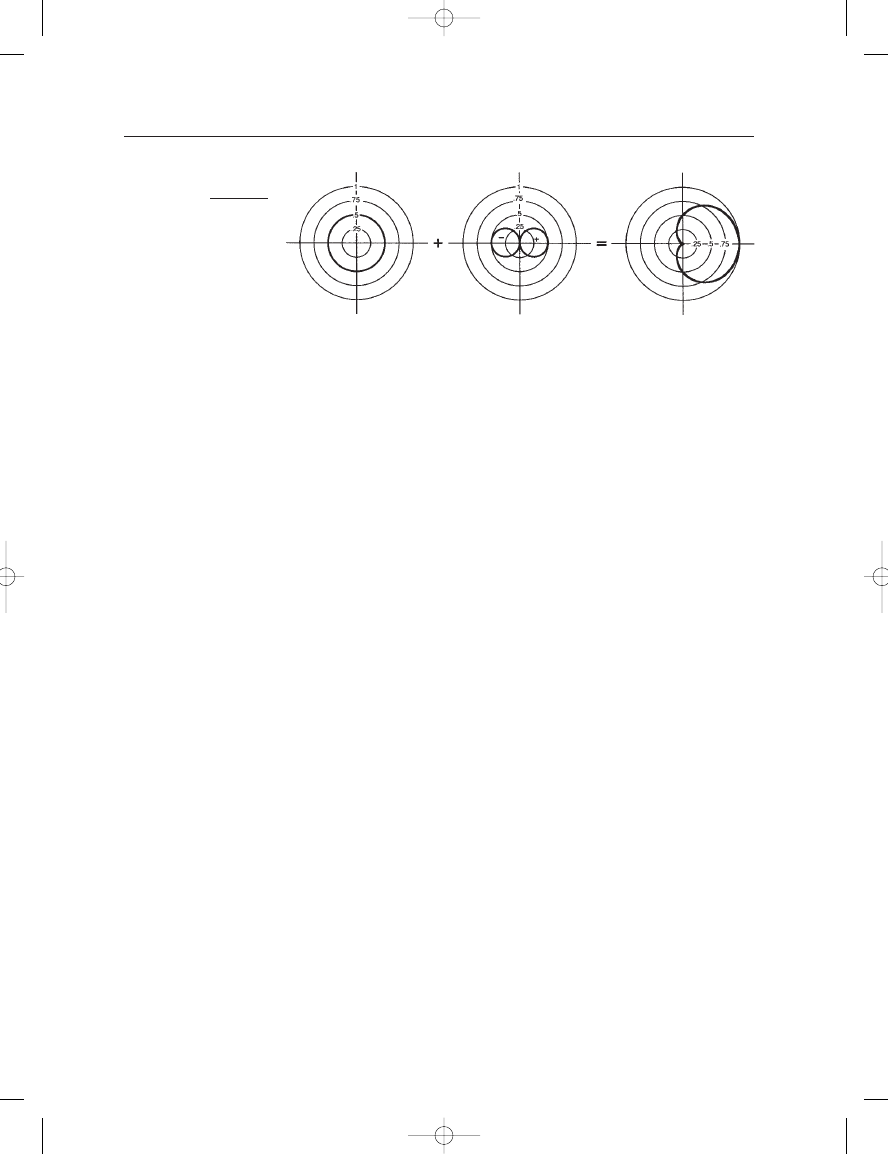ВУЗ: Казахская Национальная Академия Искусств им. Т. Жургенова
Категория: Книга
Дисциплина: Не указана
Добавлен: 03.02.2019
Просмотров: 17257
Скачиваний: 51

4: The Pressure Gradient Microphone
63
FIGURE 4-13
The capacitor gradient
microphone; single-ended
asymmetrical form (A);
single-ended symmetrical
form (B); push-pull
(electrically balanced)
form (C).
FIGURE 4-14
Effect of damping the
capacitor diaphragm.
FIGURE 4-15
Typical frequency
response curve for
capacitor gradient
microphone.
Earg_04.qxd 14/9/04 2:39 PM Page 63

PROXIMITY EFFECT
All directional microphones exhibit proximity effect, which causes an
increase in LF output from the microphone when it is operated close to
a sound source. The effect comes about because, at close working dis-
tances, the front and back paths to the diaphragm may differ substan-
tially in their relative distances from the sound source. The gradient
component acting on the diaphragm diminishes at lower frequencies,
while the inverse square component remains constant with frequency for
a given working distance. When this distance is small, as shown in
Figure 4-16A, it dominates at LF and causes the output to rise. The data
at B shows the relationship between the gradient and inverse square
forces on the diaphragm, and the equalized data shown at C indicates the
net output of the gradient microphone.
The magnitude of proximity LF boost for a gradient microphone is
given by:
(4.6)
where k
2
p
/
l
, r is the distance from the sound source (m), and
l
is the
signal wavelength (m). (For example, at an operating distance of 5.4 cm
(0.054 m) at 100 Hz, the value of kr is 2
p
(100)/344
1.8. Evaluating
equation (4.6) gives 20.16 dB.)
The rise at LF for several operating distances for a gradient micro-
phone is shown in Figure 4-17. During the 1930s and 1940s, radio
crooners soon learned to love the famous old RCA ribbon microphones,
with their “well-cushioned” LF response that so often enhanced singers’
and announcers’ voices.
For symmetrical front and back performance all figure-8 gradient
microphones must be side addressed, at 90
to the axis of the microphone’s
Boost
(dB)
20
log
1
(kr)
2
kr
THE MICROPHONE BOOK
64
FIGURE 4-16
Proximity effect in the
pressure gradient
microphone: sound
pressure levels proportional
to the square of the
distance from the source
(A); combination of inverse
square and
frequency-dependent forces
on the diaphragm (B);
electrical output of
microphone system due to
the forces shown at B (C).
Earg_04.qxd 14/9/04 2:39 PM Page 64

4: The Pressure Gradient Microphone
65
FIGURE 4-17
Typical frequency versus
operating distance response
curves for a gradient
microphone.
FIGURE 4-18
Axes of maximum
sensitivity for a variety
of microphone forms.
case, as shown in Figure 4-18. Also in this category would be most studio
large diaphragm microphones with adjustable patterns. As a general rule,
most small diaphragm models with interchangeable omni and cardioid
capsules will be end addressed, as shown in Figure 4-18.
Earg_04.qxd 14/9/04 2:39 PM Page 65

C
H
A
P
T
E
R
5
FIRST-ORDER DIRECTIONAL
MICROPHONES
INTRODUCTION
The great majority of directional microphones in professional use today
are members of the first-order cardioid family. The term first-order refers
to the polar response equation and its inclusion of a cosine term to the
first power, or order. These microphones derive their directional patterns
from combinations of the pressure and gradient microphones discussed
in the previous two chapters. By comparison, a second-order micro-
phone will exhibit a pattern dependent on the square of the cosine term.
Stated differently, a first-order microphone has response proportional to
the pressure gradient, whereas a second-order design has response that is
proportional to the gradient of the gradient.
The earliest directional microphones actually combined separate
pressure and gradient elements in a single housing, combining their out-
puts electrically to achieve the desired pattern. Today, most directional
microphones with a dedicated pattern have a single transducing element
and make use of calculated front-back delay paths to achieve the desired
pattern. We will discuss both approaches.
THE FIRST-ORDER CARDIOID FAMILY
The addition of a gradient element and a pressure element is shown in
Figure 5–1. In polar coordinates, the omnidirectional pressure element is
assigned a value of unity, indicating that its response is uniform in all
directions. The gradient element is assigned the value cos
, indicating its
bidirectional figure-8 pattern:
0.5 (1 cos ) 0.5 0.5 cos
(5.1)
which is the polar equation for a cardioid pattern (so-named for its
“heart-like” shape). The geometric construction of the pattern is derived
Earg_05.qxd 14/9/04 2:40 PM Page 66

5: First-Order Directional Microphones
67
FIGURE 5–1
Derivation of the cardioid
pattern by combination
of the pressure
(omnidirectional)
component and the
gradient (bidirectional)
component.
simply by adding the two elements at each bearing angle around the
microphone, taking account of the negative back lobe of the gradient
component.
Figure 5–2 shows several of the family of polar curves that can be pro-
duced by varying the proportions of omnidirectional (pressure) and cosine
(gradient) components. Here, the general form of the polar equation is:
A B cos
(5.2)
where A
B 1.
POLAR GRAPHS OF THE PRIMARY CARDIOID PATTERNS
Figure 5–3 shows graphs of the four main cardioid patterns normally
encountered today. The graphs are shown in both linear and logarithmic
(decibel) form.
The Subcardioid: Although other A and B ratios may used, this pat-
tern is generally represented by the polar equation:
0.7 0.3 cos
(5.3)
The pattern is shown in Figure 5–3A. The directional response is
3 dB
at angles of
90 and 10 dB at 180. Microphones of this fixed pattern
are of relatively recent development, and they have found great favor
with classical recording engineers. The subcardioid pattern is sometimes
referred to as a “forward oriented omni.”
The Cardioid: This pattern is the standard cardioid, and it is repre-
sented by the polar equation:
0.5 0.5 cos
(5.4)
This pattern is shown in Figure 5–3B. Directional response is
6 dB at
90 and effectively zero at 180. It is the most widely directional pat-
tern in general use today, its usefulness in the studio deriving principally
from its rejection of sound originating at the rear of the microphone.
The Supercardioid: This pattern is represented by the polar equation:
0.37 0.63 cos
(5.5)
The pattern is shown in Figure 5–3C. Directional response is
12 dB at
90 and 11.7 dB at 180. This pattern exhibits the maximum frontal
Earg_05.qxd 14/9/04 2:40 PM Page 67